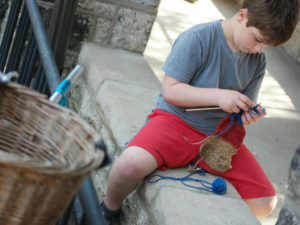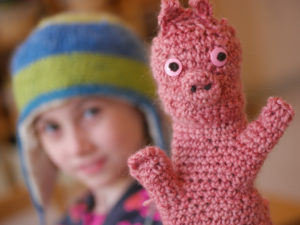
Knitting has been gathering a lot of attention lately by crafters and scientists alike. It turns out knitting and handwork provides a host of brain and wellbeing benefits to people of all ages. For students, in particular, knitting provides an essential learning medium.
A child who is knitting a hat or a toy kitten sees their will transformed into art. They see their focused, detailed work turn into something beautiful and purpose filled. They experience how the conceptual becomes concrete.
This is why Waldorf education founder, Rudolf Steiner, lectured on the importance of handwork for students just under 100 years ago.


“From Play, through Beauty, to Work: This is a golden path for education. In later life the most abstract tasks, the most difficult techniques, do not arouse antipathy if this path has been followed during childhood.”
But knitting teaches and offers more than abstract concept mastery like creating art from will or tangibles from follow through. It also teaches simple and complex mathematics; hand, eye and brain coordination; sensory integration; and resiliency of habit… all while promoting peace of mind.
Mathematics
Counting is required in knitting. Students must count stitching and rows often in complicated ways. There are different colors and different row lengths based on what’s being created, which force children to think flexibly about patterns that emerge and transform.
Those patterns and pattern thinking impressed electrical engineering professor, Dr. Karen Shoop, of Queen Mary University in London. When she took her first knitting class, she immediately saw a connection between computer coding and knitting.
As she says in this MindShift article — Can Learning to Knit Help Learning to Code:
“We ‘code’ in our outside world. …Computers ultimately started off partially inspired by weaving and the Jacquard loom, or earlier Bouchon’s loom. …Knitting instructions are largely binary [and] read just like regular expressions [of code], used for string matching and manipulation.”
It’s not just coding, according to mathematics professor, Sarah Jensen at Carthage College. It’s geometry at its most complex. As she reports in her article in Smithsonian Magazine, What Knitting can Teach You About Math, the abstract, spatial oriented, concept of rubber sheet geometry is perfectly illustrated through knitting.
“One way of knitting objects that are round – like hats or gloves – is with special knitting needles called double pointed needles. While being made, the hat is shaped by three needles, making it look triangular. Then, once it comes off the needles, the stretchy yarn relaxes into a circle, making a much more typical hat. This is the concept that rubber sheet geometry is trying to capture. All polygons become circles in this field of study.”


She says knitting also teaches “abstract algebra and topology – typically reserved for math majors in their junior and senior years of college. Yet the philosophies of these subjects are very accessible, given the right mediums.”
Last, but not least, the simple act of working with hands in math results in better learning outcomes. Studies show that using physical materials, or manipulatives as they call them, improve math skills and learning.
Eye, Hand and Brain Coordination
Many essential developmental skills are required of children as they knit and do other handwork. These include engaging in small motor skills, eye tracking, eye hand coordination, crossing the midline, bilateral hand movement and spatial oriented thinking.
Playing a stringed musical instrument, also a standard curriculum component in Waldorf schools, is often the task studied for brain benefits from these types of brain building activities. But knitting is also a multisensory experience that requires much of the same coordination, motor skills and left and right hemisphere activity as playing an instrument, and so arguably, could offer similar benefits.
Much is also written and studied about sensory engagement in brain development and knitting offers students an array of textures and colors that are pleasingly tactile and visual and offer perceptual feedback.


Resiliency Through Habit
There is a place in education for abstract concepts, but engaging students in hands-on relevant work that requires patience, persistence and follow through allows learning to really takes hold.
Students who knit must concentrate on the task at hand and must stay with it day after day. Then they are rewarded with a tangible, beautiful item. They learn to create something from nothing, they learn the value of hardwork and the value of the handmade all around us.
Rudolf Steiner put it this way, “The value of such an occupation consists in the fact that on the one hand it introduces the world of mechanism and brings movement, while on the other it trains in the power of attention.”
Wellbeing and Self Esteem
Last, but hardly least, knitting is good for the soul and good for the esteem.
As our own, Nicole Nicola, Handwork and Fine Arts Teacher, says: “Mathematics are there. We know working with the hands develop specific parts of the brain that help with other kinds of learning. All of that is absolutely true and scientifically proven and it is so important to have that academic basis, but there is another level. The self esteem building. And that is what’s missing in a lot of young people today and a lot of education.”


The New York Times Article, The Health Benefits of Knitting, focused on qualities like these, with one study looking specifically at enhanced confidence and the sense of accomplishment that comes with knitting. The article cited many other studies as well that looked at cognition and memory benefits, but also other emotional benefits including reduction in anxiety and stress, alleviation of chronic pain and the self reported happiness and confidence.
Knitting, like recess, play, social emotional learning, music and art can seem like a softer skill to pursue during a busy academic day, and yet, it is clearly an amazing tool and medium for teaching these and other essential skills to school children, especially in our STEM focused world.
But, for Steiner and for Waldorf teachers like Ms. Nicola, it goes far beyond the practical. Handwork is a way to deepen learning, not to do well on tests or get a good job, but to educate the whole child.
As Steiner said, “Headwork alone, which only occupies the intellect, does not reach the spirit.”
Republished from Waldorf Today, originally on the Loving Learning website
